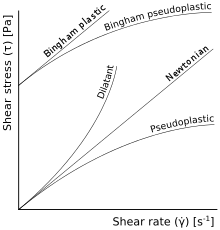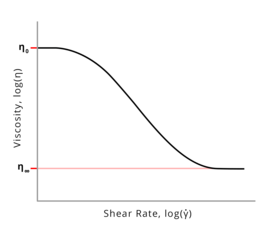Shear thinning
In rheology, shear thinning is the non-Newtonian behavior of fluids whose viscosity decreases under shear strain. It is sometimes considered synonymous for pseudoplastic behaviour,[1][2] and is usually defined as excluding time-dependent effects, such as thixotropy.[3]

Shear thinning is the most common type of non-Newtonian behavior of fluids and is seen in many industrial and everyday applications[4]. Although shear thinning is generally not observed in pure liquids with low molecular mass or ideal solutions of small molecules like sucrose or sodium chloride, it is often observed in polymer solutions and molten polymers, as well as complex fluids and suspensions like ketchup, whipped cream, blood,[5] paint, and nail polish.
Theories behind shear thinning behavior
Though the exact cause of shear thinning is not fully understood, it is widely regarded to be the effect of small structural changes within the fluid, such that microscale geometries within the fluid rearrange to facilitate shearing[6]. In colloid systems, phase separation during flow leads to shear thinning. In polymer systems such as polymer melts and solutions, shear thinning is caused by the disentanglement of polymer chains during flow. At rest, high molecular weight polymers are entangled and randomly oriented. However, when sheared at a high enough rate, these highly anisotropic polymer chains start to disentangle and align along the direction of shear[7]. This leads to less molecular/particle interaction and a larger amount of free space, decreasing the viscosity[4].
Power Law Model

At both sufficiently high and very low shear rates, viscosity of a polymer system is independent of the shear rate. At high shear rates, polymers are entirely disentangled and the viscosity value of the system plateaus at η∞, or the infinite shear viscosity plateau. At low shear rates, the shear is too low to be impeded by entanglements and the viscosity value of the system is η0, or the zero shear rate viscosity. The value of η∞ represents the lowest viscosity attainable and may be orders of magnitude lower than η0, depending on the degree of shear thinning.
Viscosity is graphed against shear rate in a log(η) vs. log() plot, where the linear region is the shear thinning regime and can be expressed using the Oswald and de Waele power law equation[8]:
The Oswald and de Waele equation can be written in a logarithmic form:
The apparent viscosity is defined as , and this may be plugged into the Oswald equation to yield a second power-law equation for apparent viscosity:
This expression can also be used to describe dilatant (shear thickening) behavior, where the value of n is greater than 1.
Herschel-Bulkley model
Bingham plastics require a critical shear stress to be exceeded in order to start flowing. This behavior is usually seen in polymer/silica micro- and nanocomposites, where the formation of a silica network in the material provides a solid-like response at low shear stress.The shear-thinning behavior of plastic fluids can be described with the Herschel-Bulkley model, which adds a threshold shear stress component to the Ostwald equation[8]:
Relationship with thixotropy
Some authors consider shear-thinning to be a special case of thixotropic behaviour, because the recovery of the microstructure of the liquid to its initial state will always require a non-zero time. When the recovery of viscosity after disturbance is very rapid however, the observed behaviour is classic shear-thinning or pseudoplasticity, because as soon as the shear is removed, the viscosity returns to normal. When it takes a measurable time for the viscosity to recover, thixotropic behaviour is observed.[9] When describing the viscosity of liquids, however, it is therefore useful to distinguish shear-thinning (pseudoplastic) behaviour from thixotropic behaviour, where the viscosity at all shear rates is decreased for some duration after agitation: both of these effects can often be seen separately in the same liquid.[10]
Everyday examples
Modern paints are examples of pseudoplastic materials. When modern paints are applied, the shear created by the brush or roller will allow them to thin and wet out the surface evenly. Once applied, the paints regain their higher viscosity, which avoids drips and runs.
Whipped cream is also an example of a shear thinning material. When whipped cream is sprayed out of its canister, it flows out smoothly from the nozzle due to the low viscosity at high flow rate. However, after whipped cream is sprayed into a spoon, it does not flow and its increased viscosity allows it to be rigid.
See also
- Shear thickening
- Non-Newtonian fluid
- Power-law fluid
- Thixotropy
- Dilatant
- Bingham plastic
- Rheology
- Kaye effect
External links
- The Great Ketchup Mystery
- NASA - The Physics of Whipped Cream NASA April 25, 2008
References:
- Mezger, Thomas G. (2006). The rheology handbook : for users of rotational and oscillatory rheometers (2., rev. ed.). Hannover: Vincentz Network. p. 34. ISBN 9783878701743.
- Heldman, R. Paul Singh, Dennis R. (2013). Introduction to food engineering (5th ed.). Amsterdam: Elsevier. p. 160. ISBN 9780124016750.
- Bair, Scott (2007). High-pressure rheology for quantitative elastohydrodynamics (1st ed.). Amsterdam: Elsevier. p. 136. ISBN 9780080475301. Retrieved 24 May 2015.
- Malvern Instruments Worldwide. "A Basic Introduction to Rheology" (PDF). Retrieved 12 December 2019.
- Tazraei, P.; Riasi, A.; Takabi, B. (2015). "The influence of the non-Newtonian properties of blood on blood-hammer through the posterior cerebral artery". Mathematical Biosciences. 264: 119–127. doi:10.1016/j.mbs.2015.03.013. PMID 25865933.
- "The Physicsof Whipped Cream | Science Mission Directorate". science.nasa.gov. Retrieved 2019-12-12.
- Inc, RheoSense. "Viscosity of Newtonian and Non-Newtonian Fluids". www.rheosense.com. Retrieved 2019-12-12.
- "Flow Properties of Polymers". polymerdatabase.com. Retrieved 2019-12-12.
- Barnes, Howard A. (1997). "Thixotropy a review" (PDF). J. Non-Newtonian Fluid Mech., 70: 3. Archived from the original (PDF) on 2016-04-30. Retrieved 2011-11-30.
- editor, David B. Troy (2005). Remington : The science and practice of pharmacy (21st ed.). Philadelphia, PA: Lippincott, Williams & Wilkins. p. 344. ISBN 9780781746731. Retrieved 24 May 2015.CS1 maint: extra text: authors list (link)